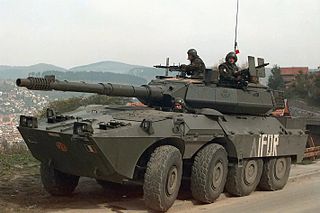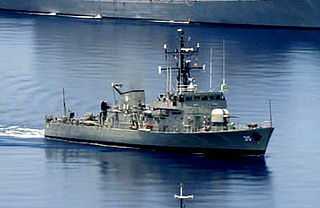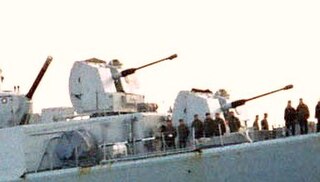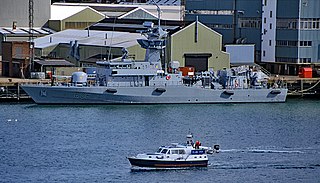
Modern French 100 mm naval guns are multipurpose artillery pieces, capable of a high rate of fire. Most modern French warships are or were equipped with one of its variants.

The FREMM, which stands for "European multi-purpose frigate", is a Franco-Italian family of multi-purpose frigates designed by Naval Group and Fincantieri. In France, this surface combatant is known as the "Aquitaine class", while in Italy it is known as the "Bergamini class". The lead ship of the class, Aquitaine, was commissioned in November 2012 by the French Navy. Italy has ordered six general purpose and four anti-submarine variants. France, on the other hand, has ordered six anti-submarine variants and two air-defense ones.
OTO Melara was a subsidiary of the Italian company Finmeccanica, today Leonardo, active in the defence sector, with factories in Brescia and La Spezia. The Mod 56 pack howitzer, in service throughout the world, and the 76mm naval gun, adopted by 53 navies and installed on over 1,000 naval vessels, are among OTO Melara's best known weapons since World War II.

The Dardo is an infantry fighting vehicle designed for the Italian Army as a replacement for the M113 APC. It is designed and built by the Iveco Fiat Oto Melara Syndicated Company based in Rome. Iveco is responsible for the hull and propulsion systems, while Oto Melara is responsible for the weapons and fire control systems.

The OTO Melara 76 mm gun is a naval autocannon built and designed by the Italian defence company OTO Melara. It is based on the OTO Melara 76/62C and evolved toward 76/62 SR and 76/62 Strales.

The Puma is a family of Italian light wheeled armoured fighting vehicle family, consisting of the Puma 6×6 and the Puma 4×4. The vehicles were developed and are produced by the Consorzio Iveco Fiat – Oto Melara for the Italian Army. First prototypes completed in 1988, with a total of five testbed vehicles being completed by 1990.

The F125 Baden-Württemberg-class frigates are a series of frigates of the German Navy, which were designed and constructed by ARGE F125, a joint-venture of Thyssen-Krupp and Lürssen. The Baden-Württemberg class is one the heaviest displacement of any class of frigates worldwide. They have replaced the Bremen class. They are primarily designed for low and medium intensity maritime stabilization operations, where they are supposed to provide sea-to-land tactical fire support, asymmetric threat control at sea and support of special forces.

The Centauro is a family of Italian military vehicles originating from a wheeled tank destroyer for light to medium territorial defense and tactical reconnaissance. It was developed by a consortium of manufacturers, the Società Consortile Iveco Fiat - OTO Melara (CIO). Iveco Fiat was tasked with developing the hull and propulsion systems while Oto Melara was responsible for developing the turrets and weapon systems.

The OTO Main Anti-aircraft Tank for Intercept and Combat was an Italian self-propelled anti-aircraft gun (SPAAG) prototype. Designed and built by OTO Melara, it was armed with a single 76 mm naval gun.

ARM Baja California (PO-162) is a Oaxaca-class patrol vessel, constructed by and for the Mexican Navy.

The BRP Emilio Jacinto (PS-35) is the lead ship of the Jacinto-class corvettes currently assigned to the Offshore Combat Force of the Philippine Fleet. She is one of few ships in the Philippine Navy equipped with modern systems after the completion of combat, navigation and weapon systems upgrade of her class in August 2019. She was originally called HMS Peacock (P239) during her service with the Royal Navy.

The BRP Apolinario Mabini (PS-36) is the second ship of the Jacinto-class corvettes currently assigned to the Offshore Combat Force of the Philippine Fleet. She is one of few ships in the Philippine Navy equipped with modern systems after the completion of combat, navigation and weapon systems upgrade of her class in August 2019. She is named after Apolinario Mabini, a hero of the Philippine revolution and a former prime minister. She was originally called HMS Plover (P240) during her service with the Royal Navy.

The Oto Melara 127/64 Lightweight (LW) naval gun mount is a rapid-fire gun mount suitable for installation on large and medium size ships. It also has a version for coastal defense, intended for surface fire and naval gunfire support as main role and anti-aircraft fire as secondary role. The compactness of the gun feeding system makes installation on narrow section crafts possible.

The 76mm/L62 Allargato is a single barrel, medium caliber, dual purpose automatic naval cannon designed and produced in the 1960s by the Italian defence firm of OTO-Melara as the cannon armament for all medium and large warships built for the Italian Navy in that decade. Currently, the gun remains in service with Italy's Cassiopea-class patrol vessels but has otherwise been largely replaced by the Otobreda 76 mm series of cannons.

ARM Oaxaca (PO-161) is the lead ship of the Oaxaca class of patrol vessels, constructed by and for the Mexican Navy.

The Oerlikon KBA is a 25 mm (25×137mm) autocannon, developed as a close range multipurpose weapon for the mechanised battlefield, originally made by Oerlikon and currently produced in Rheinmetall Italia S.p.A. facilities. It is a positively locked breech, gas-operated cannon with a rotating bolt head and a dual-belt selective feed system taking a 25mm NATO cartridge. The rate of fire in burst mode is 600 rounds per minute but it can be adjusted electronically and reduced to single shot or a selectable range from 100 up to 200 rounds per minute.

The 152 mm /55 Model 1934–1936 were built for the Italian Navy in the years before World War II. These guns were used on the Duca degli Abruzzi-class Light cruisers, which were the final series of the Condottieri-class cruisers as their primary armament and as secondary armament on the Littorio-class battleships.

The Qatari Emiri Navy (QEN), also called the Qatari Emiri Naval Forces (QENF), is the naval branch of the armed forces of the State of Qatar.
Hitfist OWS is a remotely operated turret, for armored vehicles, developed by the Italian Oto Melara and derived from Hitfist.

Oto Melara Hitfist is a two-man turret, for armored vehicles, developed by the Italian Oto Melara. The turrets are designed to mount a 25mm Oerlikon KBA or 30/40mm ATK Mk44 Bushmaster II autocannon. The main armament may mount a co-axial machine gun. A variant allows the operator to aim and fire anti-tank missiles.



















